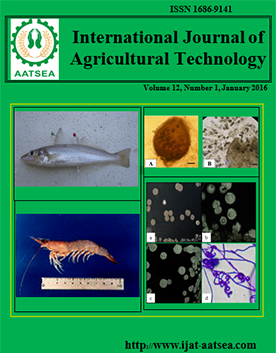Fungal inhibiting capacity of an ethnobotanical plant from imugan, nueva vizcaya against Fusarium oxysporum and Fusarium moniliforme
Main Article Content
Abstract
Ethnobotany pertains to the scientific association between people and plants. In the Philippines, many researches have been upraised to review the current ethnobotanical state and pharmacological properties of plants thriving for many indigenous tribes. One specific plant used by the Kalanguya tribe of the Northeastern Philippines is Derris elliptica, locally known as Derris elliptica, used as a fish poison, and only minor information was known about this indigenous plant’s taxonomy. This research was undertaken to evaluate the fungal-inhibiting capability of Derris elliptica against two fungal plant pathogens Fusarium oxysporum and Fusarium moniliforme. Hot water extracts of Derris ellipticaexhibited fungal inhibition to F. oxysporum as indicated by a retarded mycelial growth response (26.35 mm) compared to its negative control (70.07 mm) after five (5) days of incubation. The same observation was also exuded against F. moniliforme which also exhibited slow mycelial growth (28.28 mm) compared to the negative control (70.86 mm). Furthermore, hotwater extracts of D. elliptica can be considered as a fungal-inhibitor against these common plant pathogens comparable to commercially available fungal-inhibitory drugs and chemicals.
Article Details

This work is licensed under a Creative Commons Attribution-NonCommercial-NoDerivatives 4.0 International License.
References
Acharya, D. and Anshu, S. (2008). Indigenous herbal medicines: Tribal formulations and traditional herbal practices, Aavishkar Publishers Distributor, Jaipur, India. pp. 440.
Burton, R., Cannon, J., Owen, N., and Wood, S. (2004). Naturally occuring fish poisons from plants. Journal of Chemical Education 81:1457-1461.
Corpuz, A. G. (1999). The colonial iron horse: railroads and regional development in the Philippines. pp. 1875-1935.
Frutos, P., Hervas, G., Giraldez, F. and Mantecon, A. (2004). Review. Tannins and ruminant nutrition. Spanish Journal of Agricultural Research 2:191-202.
Lasco, R. and Villamor, G. (2005). The ikalahan ancestral domain, the Philippines. World Agroforestry Centre (ICRAF), Los Banos, Philippines. pp. 43-50.
Nelson, P. E., Dignani, M. C. and Anaissie, E. J. (1994). Taxonomy, biology, and clinical aspects of Fusarium species. Clinical Microbiology Reviews 7:479-504.
Sierotzki, H. (2000). Mode of resistance to respiration inhibitors at the cytochrome bc1 enzyme complex of Mycosphaerella fijiensis field isolates Pest Management Science 56:833-841.
Welch, J. R., Vincent, J. R., Auffhammer, M., Dobermann, A., Moya, P. and Dawe, D. (2010). Rice yields in tropical/subtropical Asia exhibit large but opposing sensitivities to minimum and maximum temperatures. Proceedings of the National Academy of Sciences of the United States of America 107:14562-14567.
Wooley, J. (2001). Plant Alkaloids. Encyclopedia of Life Sciences. Nature Publishing Group. pp. 1-11.
Zhang, H., Qiu, M., Chen, Y., Chen, J., Sun, Y., Wang, C. and Fong, H. (2014). Plant Terpenes. Phytochemistry and Pharmacognosy. Encyclopedia of Life Support Systems. pp. 1-9.


